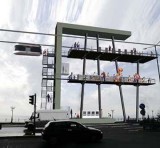Supervisors:
2006
In the frantic paces that are imposed by the modern way of living in the city, being in motion is a daily routine for most of its inhabitants, moving to work, to fulfil different obligations and social affairs. In a time that the quality of life is inevitably connected with time, saving every minute is more of a stressful goal rather than a promising, of that quality, idea. Roads get crammed with cars, taxi -cabs, buses, electric trolley buses, trams- passengers are jammed in wagons and even in the case of the private vehicle’s comfort or the theoretical instant, private convenience of a taxi, the street’s traffic, the every day’s jam, that can be created everywhere by the most insignificant cause, transform the transit to the desirable destination into a stressful and hectic procedure-a waste of the valuable, ‘modern’ time.
In the city of Athens, a characteristic example of a city with such problems, is where the present study is focusing, suggesting the installation of a new, suspended mean of public transport, the HypAIRtram.
The HypAIRtram is a mass transit system, with characteristics similar to those of the train and metro, such as the fixed frequency of vehicles passing, the predefined routes, the massive service of passengers, moving in a level that does not affect, at least directly, the city’s circulation in total. Its connection with the ground and the urban life is accomplished with vertical circulation axis. This vertical displacement of a public use-function in the city’s aerial space further creates a new level-field of growth for public activities-uses, similar to those that are often developed near or along with the public transportation networks of the ground level.
The placing of the HypAIRtram is proposed to the existing tram’s route from Syntagma to Glyfada, replacing it and mainly taking advantage of the urban adjusting that the areas crossed by the tram have already been subjected to.
The basic elements of the network that have been studied are the vehicles, the supporting pylons, that are placed every 100m, the stations-public platforms, in a 400m distance, a central station with additional functions and uses of public character in the beach of Edem and the terminal station where the vehicles are being repaired and stored.


